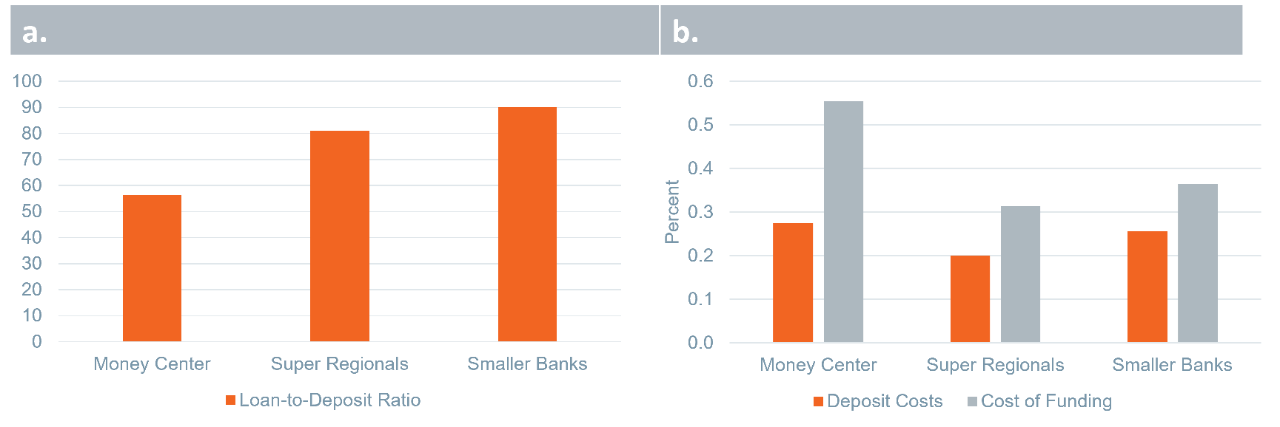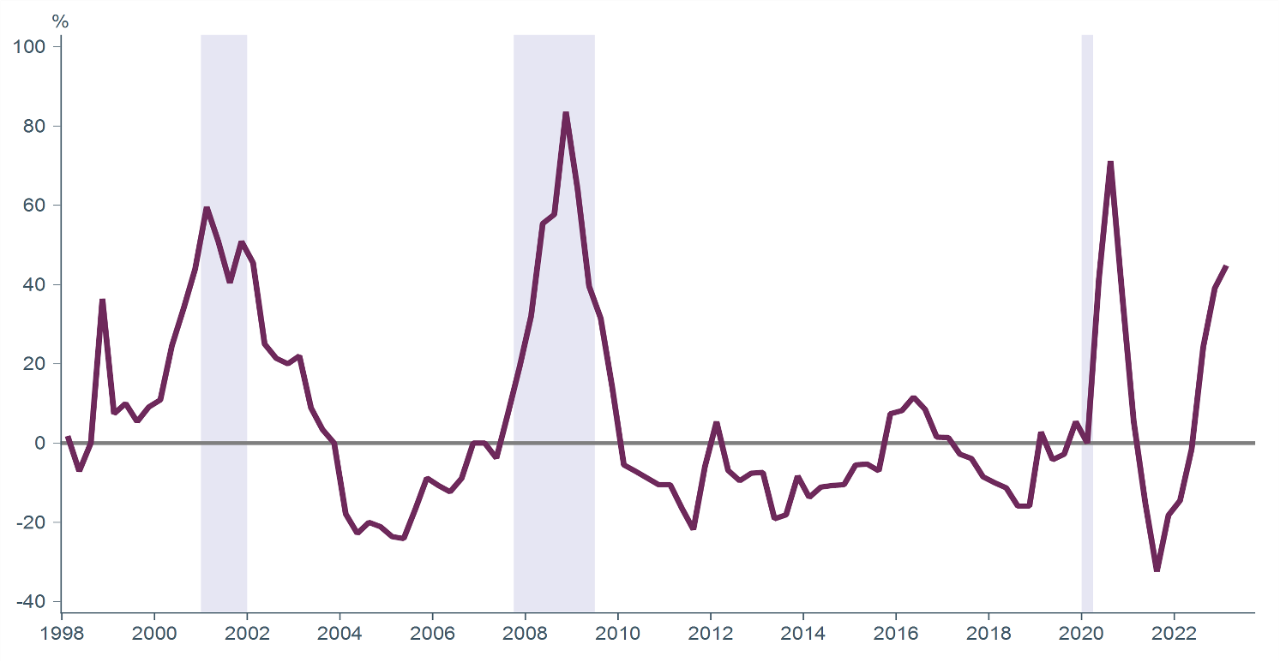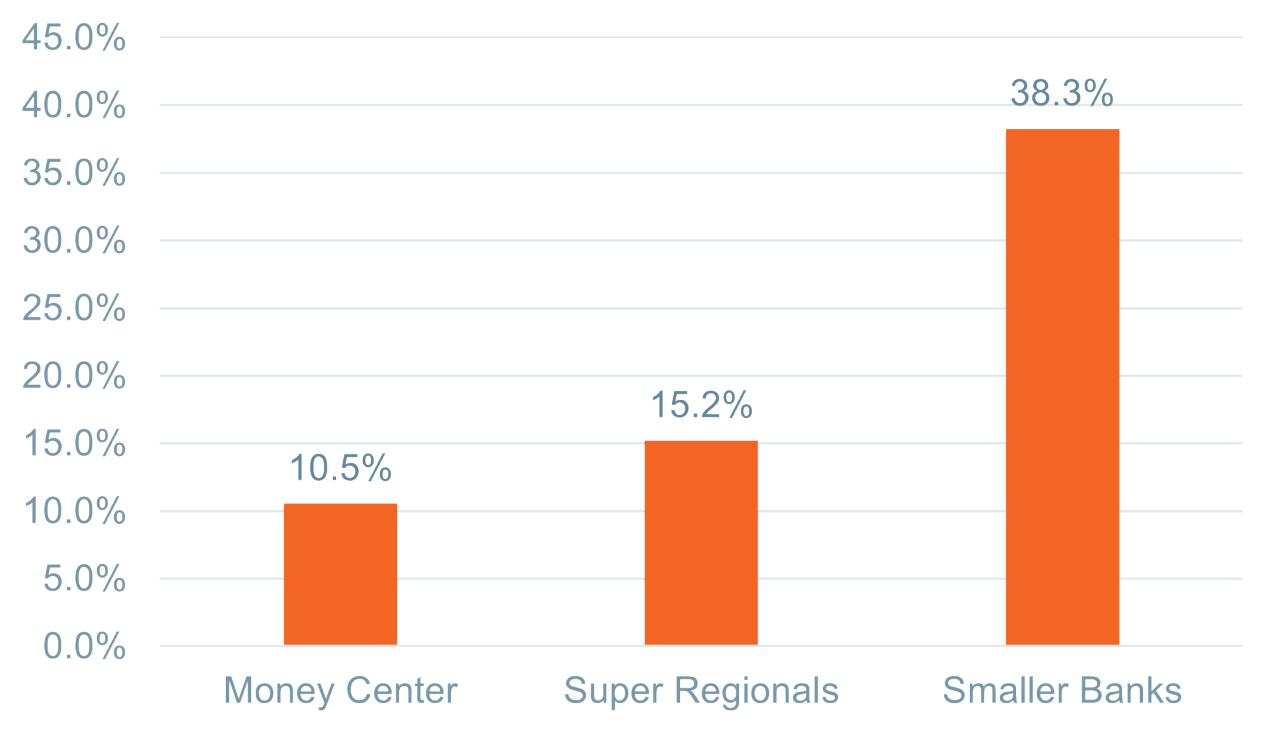 Equal Housing Lender. Bank NMLS #381076. Member FDIC.
Equal Housing Lender. Bank NMLS #381076. Member FDIC.
 Equal Housing Lender. Bank NMLS #381076. Member FDIC.
Equal Housing Lender. Bank NMLS #381076. Member FDIC.
Small, mid-sized, and regional banks are critical to the health and functioning of the U.S. economy. However, the failure of three regional banks in as many months (two of which rank in the top-three bank failures of all time) has raised questions about the safety and stability of this important part of the banking system.
The hyper-low-rate environment that followed the post-global financial crisis (GFC) gave super regional and other small-to-mid-sized banks expanded scope to increase lending activity and profitability in numerous sectors. By contrast, the fastest pace of monetary policy tightening in decades had a largely unanticipated effect on bank balance sheets, particularly on the ability of small and mid-sized banks to competitively fund themselves through deposits. In the higher-rate environment, deposits became steeply more expensive not only as cash sought higher yields available elsewhere, especially money market funds, but also because small and mid-sized banks experienced a safety taint following the failure of three high-profile banks. The latter caused deposits to migrate to the safety associated with global systemically important banks (GSIBs), or, more colloquially, the “too big to fail” larger banks. In light of the elevated costs of short-term funding and the steeply inverted yield curve—meaning that banks raising capital in short-maturity markets paid more than they received lending it out in longer-maturity securities—the earnings power of these small and mid-sized banks has been temporarily impaired.
In addition to these challenges on the liability side of small and mid-sized bank balance sheets, the asset-side has also seen difficulties. Specifically, longer-maturity assets such as Treasury bonds experienced significant declines in value due to the unexpected and rapid increase in interest rates. So just as cash started to flow out of these banks—to the extent their assets were invested in unhedged, longer-dated bonds and loans—those assets declined in value, leaving less capital available to fund the deposit withdrawals. This constitutes an asset-liability mismatch and, as mentioned, has thus far proven fatal to three institutions.
Today, the Fed’s process of raising the federal funds rates is likely behind us either in large part or in totality. The pressures that banks faced in recent months are unlikely to repeat. Not only is the Fed likely done raising rates, in our view, economic weakness in the second half of the year could bring with it a decline in rates that would further alleviate the asset-liability mismatch issues for bank balance sheets (though credit quality could suffer). What’s more, going forward, as is common with these types of events, bank management and regulators are likely to be far more attuned to this particular risk, unlikely to repeat the same mistake anytime soon.
The remainder of this piece focuses on what higher cost of funding for super regional, small- and mid-sized banks means for the industry and the economy. We also discuss the prospects for increased regulation and how that may slow lending, further compromising the bottom line of these banks. All of this results in a near-term environment where small and mid-sized banks may struggle to compete with large money-center banks, and their reduced activity could weigh on the overall economy.
The post-GFC advantage to small banks
There are several ways of defining banks by size. We choose to break the banking landscape into three categories: First, there are money center banks, which include the four largest by total assets, designated by regulators as GSIBs. Second, are banks with assets above $100 billion, defined as super regionals. These banks follow a regional or community bank model but have significantly more scale than the third category: small- and mid-sized banks. In our analysis, this last group includes banks with less than $100 billion in assets, typically operating across a smaller regional footprint and with a more localized community bank model (Figure 1). Notably, those in the third category are subject to a less rigorous regulatory regime, including that they are not subject to periodic capital adequacy stress testing by regulators.
Figure 1: Lay of the banking land
Categories of banks by business model, market capitalization, and total assets

Sources: Bloomberg, WTIA. Note: There are more than 4,000 banks in the U.S. as of January 1, 2023. We focus our analysis on the categories above. We include four banks in the category of “money center,” and limit it to the institutions that focus on traditional banking activities. Our analysis for small- and mid-sized banks includes only the 100 largest banks with assets <$100B.
In the aftermath of the GFC, large money center banks were weighed down by balance sheet cleanup and heightened regulatory scrutiny, given their central role in the financial crisis. Policymakers were focused on preventing the biggest banks from ever again posing a systemic risk to the financial system. A key piece of legislation was the 2010 Dodd-Frank Act, which established that GSIBs must meet minimum liquidity and certain risk-based capital ratios—including Tier 1 capital ratios, a measure of the amount of highest-quality assets being held as reserves on bank balance sheets. This required the largest banks to build up their capital buffers and limit certain forms of lending and investment.
Regional and small-to-mid-sized banks largely remained out of the regulatory crosshairs (and even received preferential treatment in some cases, including debit interchange fees) while benefiting from a void left by big banks. Low interest rates, cheap funding costs, and caps on further growth of large money center banks gave smaller banks runway to grow their loan books across commercial and industrial (C&I), commercial real estate (CRE), and residential real estate.
A new regime
In today’s environment, the formula for success has changed. Interest rates have moved sharply higher over the past 14 months. Higher interest rates, an inverted yield curve, and increased regulatory scrutiny are pressuring the profitability of all banks. Banks will have to pay higher deposit costs or risk losing deposits. Deposits are the primary funding tool for bank operations. It is worth noting that deposit flight, whereby depositors looking for higher rates or safety may jump to another banking institution or to a higher-yielding money market fund, poses a greater disruption to those banks with a higher loan-to-deposit ratio (Figure 2a). This is because a higher percentage of deposits are tied up in longer maturity loans and not available for depositor withdrawal.
The large money center banks also benefit in this environment from their practice of securitizing loans. This process involves packaging loans as securities for sale, which brings in additional capital and moves the loans off their balance sheets. This activity serves two purposes. First, it relieves some of the reliance on deposits by raising fresh cash. Second, it alleviates some of the risks surrounding asset/liability mismatches. (An asset-liability mismatch can occur when shorter-term liabilities—deposits—are paired against longer-maturity assets—loans—on the bank’s balance sheet. This can become problematic if the liabilities leave the bank too quickly.) Super regional, small, and mid-sized banks typically do not utilize this strategy, and it is a key factor that has resulted in balance sheet stress for many of them in the current environment.
Historically, super regional and smaller banks have enjoyed lower deposit costs and overall costs of funding (Figure 2b),[1] mainly due to regulatory costs and capital requirements. That cost-of-funding advantage could now reverse to favor GSIBs. Higher overall cost of funding for super regional or smaller banks could restrict lending appetite to important areas of the economy.
Figure 2: Small banks carry more deposit risk
Loan-to-deposit and deposit costs by bank category

As of April 30, 2023. Source: Bloomberg.
The other key factor is regulation. Post-GFC legislation took a stricter approach to the largest money center banks, while requiring less of smaller banks. Then in 2019, the Federal Reserve revised its framework for regulation by further reducing the stringency of regulation on non-GSIBs.[2] The lighter regulatory framework is evidenced by an average Tier 1 capital ratio of 14% for the largest money center banks compared to 11% for super regional and small and mid-sized banks.[3] Soon after the failure of Silicon Valley Bank (SVB) (as early as his March 28 testimony to Congress), Federal Reserve Vice Chair for Supervision Michael Barr signaled that more regulation could be coming for smaller banks,[4] though we would expect additional regulation to be phased in gradually over the span of several years to give institutions better ability to adapt. While some changes to regulatory standards may require congressional approval, regulators (the Fed, the FDIC, and the Office of the Comptroller of the Currency) already possess significant powers under existing laws.[5] Higher capital and liquidity requirements, along with more onerous stress tests, mean increased cost of funding for small banks and less available and willing capital for lending. This outcome would compound the tightening of lending standards that was already under way before the failure of SVB (Figure 3).
There are other policy changes that could result from deposit stress, including a potential increase in the cap on FDIC insurance or even unlimited coverage for some or all depositors. The burden of such a change could be borne more by larger banks through higher assessments to the Deposit Insurance Fund (DIF). Absent a systemic crisis, significant changes to the FDIC insurance regime would require congressional action, though some options may be within the scope of the FDIC’s rulemaking authority.[6]
Figure 3: Banks were already tightening standards ahead of SVB failure
Senior Loan Officer Opinion Survey, net percentage of banks tightening lending standards (C&I loans to large/medium firms)

Data as of March 31, 2023. Sources: Bloomberg, Federal Reserve.
With bank failures top of mind, industry consolidation has been a long and habitual feature of the U.S. banking industry. In the relatively short period from 2000 to 2023, there have been 567 bank failures,[7] and still the U.S. boasts more than 4,000 banks.[8] Higher interest rates and increased regulatory oversight are making it more difficult for smaller banks to earn their cost of capital and are resulting in retrenchment by lenders. Increased regulation could lead super regional banks to try to emulate their larger money center peers in scale and business focus, which may also result in further industry consolidation. However, small and mid-sized banks are a critical part of the U.S. banking landscape. We expect every effort to be made on the part of policymakers to protect these banks and the role they play in serving communities around the country.
Core narrative
What does this mean for banks and the broader economy? Importantly, we continue to assess bank contagion risks as limited. First, steps taken by the government at the onset of the banking stress were generally effective in stemming the crisis of confidence. Going forward, the pace of interest rate increases is very unlikely to continue, and we would not expect it to repeat again anytime soon.. As rates move lower, asset-liability mismatch challenges will recede. In addition, we expect bank management and regulators to place greater focus on interest rate risk, in addition to credit quality risks that were an important artifact of the GFC.
However, there are a number of small-to-mid-sized banks whose stock prices indicate significant ongoing stress. While we don’t foresee systemic contagion, we do believe that a small number of these are likely in some way to be absorbed into other institutions. Also, since super regional and small and mid-sized banks today play an outsized role relative to large money center banks in key areas of the economy, a pullback in lending due to higher deposit costs, higher overall funding costs, or more arduous regulation increases the chance of a recession. In particular, smaller banks are a major source of credit to the CRE sector (Figure 4). (We discuss the risks to super regional, small and mid-sized banks stemming from CRE in a separate blog post.) We hold an underweight to risk assets in client portfolios, including to U.S. small-cap equities, and will continue to closely follow developments in the banking sector.
Figure 4: Small banks punch above their weight in CRE
CRE loans as % total, by bank category

As of April 30, 2023. Source: Bloomberg.
[1] Cost of funding is defined as deposit costs plus other borrowing costs.
[2] https://www.federalreserve.gov/newsevents/testimony/barr20230328a.htm
[3] Source: Bloomberg.
[4] https://www.federalreserve.gov/newsevents/testimony/barr20230328a.htm
[5] Source: Politico, https://www.politico.com/news/2023/03/30/biden-fed-regional-banks-svb-00089686
[6] Source: FDIC, https://www.fdic.gov/news/press-releases/2023/pr23035.html
[7] Source: FDIC, https://www.fdic.gov/resources/resolutions/bank-failures/failed-bank-list/
[8] Source: FDIC, https://banks.data.fdic.gov/explore/historical?displayFields=STNAME%2CTOTAL%2CBRANCHES%2CNew_Char&selectedEndDate=2022&selectedReport=CBS&selectedStartDate=1934&selectedStates=0&sortField=YEAR&sortOrder=desc
Facts and views presented in this report have not been reviewed by, and may not reflect information known to, professionals in other business areas of Wilmington Trust or M&T Bank who may provide or seek to provide financial services to entities referred to in this report. M&T Bank and Wilmington Trust have established information barriers between their various business groups. As a result, M&T Bank and Wilmington Trust do not disclose certain client relationships with, or compensation received from, such entities in their reports.
The information on Wilmington Wire has been obtained from sources believed to be reliable, but its accuracy and completeness are not guaranteed. The opinions, estimates, and projections constitute the judgment of Wilmington Trust and are subject to change without notice. This commentary is for informational purposes only and is not intended as an offer or solicitation for the sale of any financial product or service or a recommendation or determination that any investment strategy is suitable for a specific investor. Investors should seek financial advice regarding the suitability of any investment strategy based on the investor’s objectives, financial situation, and particular needs. Diversification does not ensure a profit or guarantee against a loss. There is no assurance that any investment strategy will succeed.
Past performance cannot guarantee future results. Investing involves risk and you may incur a profit or a loss.
Indexes are not available for direct investment. Investment in a security or strategy designed to replicate the performance of an index will incur expenses such as management fees and transaction costs which will reduce returns.
Reference to the company names mentioned in this blog is merely for explaining the market view and should not be construed as investment advice or investment recommendations of those companies. Third party trademarks and brands are the property of their respective owners.
Stay Informed
Subscribe
Ideas, analysis, and perspectives to help you make your next move with confidence.
What can we help you with today